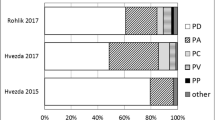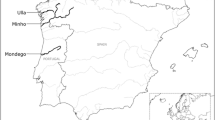Abstract
In the Baltic Sea, the great sandeel (Hyperoplus lanceolatus), a common fish species that inhabits sandy substrates, is an important element in the diet of marine mammals, sea birds, and piscivorous fish. It can also act as a transmitter of parasites to its predators, but parasitological studies on this species are limited. We sampled great sandeels in April 2016 in two areas of the southern Baltic Sea (SB—south of Bornholm and GG—the Gulf of Gdansk) and found parasitic anisakid nematodes in both locations. The only one species of nematode parasites has been detected: liver worm (Contracaecum osculatum) with average prevalence of infection 8.96%. This is the first study to report on infection of H. lanceolatus with anisakid nematodes in the southern Baltic Sea and our results suggest that the great sandeel may play a role in the transmission of liver worm in the food web of this marine environment.

Similar content being viewed by others
References
Barrett RT, Røv N, Loen J, Montevecchi WA (1990) Diets of shags Phalacrocorax aristotelis and cormorants P. carbo in Norway and possible implications for gadoid stock recruitment. Mar Ecol Prog Ser 66:205–218
Berland B (1961) Nematodes from some Norwegian marine fishes. Sarsia 2:1–50
Berland B (1989) Identification of larval nematodes from fish. In: Möller H (ed) Nematode problems in North Atlantic fish. Report from a workshop in Kiel, 3–4 April 1989. ICES C.M./F6:16–22
Boström MK, Lunneryd SG, Ståhlberg H, Karlsson L, Ragnarsson B (2012) Diet of the great cormorant (Phalacrocorax carbo sinensis) at two areas at Lövstabukten, South Bothnian Sea, Sweden, based on otolith size-correction factors. Ornis Fenn 89:157–169
Bush AO, Lafferty KD, Lotz JM, Shostak AW (1997) Parasitology meets ecology on its own terms: Margolis et al. revisited. J Parasitol 83(4):575–583
Fagerholm H-P (1978) New implications of the nematode infection of Baltic cod liver. Preceedings of the 4th International Congress of Parasitology, Warszawa, Section C, 192
Fagerholm H-P (1982) Parasites of fish in Finland. VI. Nematodes. Acta Acadamiae Aboensis, Series B 40:1–128
Frimodt C (1995) Multilingual illustrated guide to the world’s commercial coldwater fish. Fishing News Books, Osney Mead, Oxford 215 p
Galassi S, Bettinetti R, Neri MC, Jeannot R, Dagnac T, Bristeau S, Sakkas V, Albanis T, Boti V, Valsamaki T, Falandysz J, Schulte-Oehlmann U (2008) A multispecies approach for monitoring persistent toxic substances in the Gulf of Gdańsk (Baltic sea). Ecotoxicol Environ Saf 69:39–48
Galatius A, Olsen MT (2014) Seals in the Baltic. Nat Bornh 12:68–74 [in Danish]
Groenewold S, Berghahn R, Zander CD (1996) Parasite communities of four fish species in the Wadden Sea and the role of fish discarded by the shrimp fisheries in parasite transmission. Helgolander Meeresun 50:69–85
Haarder S, Kania PW, Galatius A, Buchmann K (2014) Increased Contracaecum osculatum infection in Baltic cod (Gadus morhua) livers (1982−2012) associated with increasing grey seal (Halichoerus gryphus) populations. J Wildl Dis 50:537–543
Herreras MV, Montero FM, Marcogliese DJ, Raga JA, Balbuena JA (2007) Phenotypic tradeoffs between egg number and egg size in three parasitic anisakid nematodes. Oikos 116:1737–1747
Hiby L, Lundberg T, Karlsson O, Watkins J, Jüssi M, Jüssi I, Helander B (2007) Estimates of the size of the Baltic grey seal population based on photo-identification data. NAMMCO Sci Publ 6:163–175
Horbowy J, Podolska M, Nadolna-Ałtyn K (2016) Increasing occurrence of anisakid nematodes in the liver of cod (Gadus morhua) from the Baltic Sea: does infection affect the condition and mortality of fish? Fish Res 179:98–103
Klimpel S, Rückert S (2005) Life cycle strategy of Hysterothylacium aduncum to become the most abundant anisakid fish nematode in the North Sea. Parasitol Res 97:141–149
Köie M, Fagerholm H-P (1995) The life cycle of Contracaecum osculatum (Rudolphi, 1802) sensu stricto (Nematoda, Ascaridoidea, Anisakidae) in view of experimental infections. Parasitol Res 81(6):481–489
Lack D (1945) The ecology of closely related species with special reference to cormorant (Phalacrocorax carbo) and shag (P. aristotelis). J Anim Ecol 14(1):12–16
Leiro J, Parama A, Ortega M, Santamarina MT, Sanmartin ML (1999) Redescription of Glugeacaulleryi, a microsporidian parasite of the greater sand-eel, Hyperopluslanceolatus (Le Sauvage), (Teleostei: Ammodytidae), as Microgemmacaulleryi comb. Nov. J Fish Dis 22:101–110
Lundström K, Hjerne O, Lunneryd SG, Karlsson O (2010) Understanding the diet composition of marine mammals: grey seals (Halichoerus grypus) in the Baltic Sea. ICES J Mar Sci 67:1230–1239
Lunneryd SG, Boström MK, Aspholm PE (2015) Sealworm (Pseudoterranova decipiens) infection in grey seals (Halichoerus grypus), cod (Gadus morhua) and shorthorn sculpin (Myoxocephalus scorpius) in the Baltic Sea. Parasitol Res 114:257–264
Marcogliese DJ (2002) Food webs and the transmission of parasites to marine fish. Parasitology 124(7):83–99
McClelland G (2005) Nematoda (roundworms). In: Rohde K (ed) Marine parasitology. CABI Publishing, Wallingford, pp 104–115
McClelland G, Misra RK, Martell DJ (1990) Larval anisakine nematodes in various fish species from Sable Island Bank and vicinity. Can B Fish Aquat Sci 222:83–118
Mehrdana F, Bahlool QZ, Skov J, Marana MH, Sindberg D, Mundeling M, Overgaard BC, Korbut R, Strøm SB, Kania PW, Buchmann K (2014) Occurrence of zoonotic nematodes Pseudoterranova decipiens, Contracaecum osculatum and Anisakis simplex in cod (Gadus morhua) from the Baltic Sea. Vet Parasitol 205:581–587
Nadolna K, Podolska M (2014) Anisakid larvae in the liver of cod (Gadus morhua) L. from the southern Baltic Sea. J Helminthol 88:237–246
Nebel SE (2011) The consumption of commercially valuable fish by pinnipeds in Northwest Icelandic waters. Master’s thesis. University of Akureyri
O’Connell MP, Fives JM (2004) Helminth communities of the lesser sandeel Ammodyte stobianus L. off the west coast of Ireland. J Parasitol 90(5):1058–1061
Ólafsdottir D, Hauksson E (1998) Anisakid nematodes in the common seal (Phoca vitulina L.) in Icelandic waters. Sarsia 83:309–316
Pachur M, Horbowy J (2013) Food composition and prey selection of cod, Gadus morhua (Actinopterygii: Gadiformes: Gadidae), in the southern Baltic Sea. Acta Ichthyol Piscat 43(2):109–118
Palm HW, Klimpel S (2007) Evolution of parasitic life in the ocean. Trends Parasitol 23:10–12
Reichholf JH, Steinbach G (1994) Encyclopedia of fish—freshwater and marine fish in Europe. Muza SA p 297 [in Polish]
Riede K (2004) Global register of migratory species—from global to regional scales. Final report of the R&D-Projekt 808 05 081. Federal Agency for Nature Conservation, Bonn, p 329
Rokicki J, Rolbiecki L (2002) Colonization of the round goby, Neogobius melanostomus (Gobiidae) by parasites in the new environment of the Gulf of Gdańsk (Southern Baltic). Wiad Parazytol 48:197–200
Rolbiecki L (2006) Parasites of the round goby, Neogobius melanostomus (Pallas, 1811), an invasive species in the Polish fauna of the Vistula Lagoon ecosystem. Oceanologia 48:545–561
Rutkowski S (1982) Encyclopedia of marine fish. Wydawnictwo morskie Gdańsk p 484–485 [in Polish]
Salminen M, Erkamo E, Salmi J (2001) Diet of post-smolt and one-sea-winter Atlantic salmon in the Bothnian Sea, Northern Baltic. J Fish Biol 58:16–35
Silva MA (1999) Diet of common dolphins, Delphinus delphis, off the Portuguese continental coast. J Mar Biol Assoc U K 79(3):531–540
Skrzypczak M, Rolbiecki L (2015a) Helmintofauna of turbot Scophthalmus maximus (Linnaeus, 1758) from the southern Baltic Sea including new data. Pol J Vet Sci 18(3):599–605
Skrzypczak M, Rolbiecki L (2015b) [Rola tobiasza Ammodytes tobianus (Pisces: Ammodytidae) w krążeniu nicieni z rodzaju Contracaecum (Anisakidae).] The role of small sandeel Ammodytes tobianus (Pisces: Ammodytidae) in circulation of nematodes from genus Contracaecum (Anisakidae). XXI Zjazd Polskiego Towarzystwa Zoologicznego, Zielona Góra, 11–13.09.2015. Conference materials: 71
Skrzypczak M, Rolbiecki L (2016) Preliminary studies on helminth communities of small sandeel, Ammodytes tobianus L. (Actinopterygii: Ammodytidae), from the Gulf of Gdańsk and Pomeranian Bay, Poland. Ann Parasitol 62(supplement):67
Skrzypczak M, Rokicki J, Pawliczka I, Najda K, Dzido J (2014) Anisakids of seals found on the southern coast of Baltic Sea. Acta Parasitol 59(1):165–172
Smout S, Rindorf A, Hammond PS, Harwood J, Matthiopoulos J (2014) Modelling prey consumption and switching by UK grey seals. ICES J Mar Sci 71(1):81–89
Sprehn C (1960) Trematoda und Cestoidea. - Tierw. Mitteleur 1:361–392
Stempniewicz L (1986) The food intake of two scoters Melanitta fusca and M. nigra wintering in the Gulf of Gdańsk, Polish Baltic coast. VarFagelv Suppl 11:211–214
Suuronen P, Lehtonen E (2012) The role of salmonids in the diet of grey and ringed seals in the Bothnian Bay, northern Baltic Sea. Fish Res 125– 126:283–288
Szostakowska B, Fagerholm HP (2007) Molecular identification of two strains of third-stage larvae of Contracaecum rudolphii sensu lato (Nematoda: Anisakidae) from fish in Poland. J Parasitol 93:961–964
Ustups D, Urtans E, Minde A, Uzars D (2003) The structure and dynamics of fish communities in the Latvian coastal zone (Pape - Pērkone), Baltic Sea. Acta Univ Latv 662:33–44
Ustups D, Bergström U, Florin AB, Kruze E, Zilniece D, Elferts D, Knospina E, Uzars D (2016) Diet overlap between juvenile flatfish and the invasive round goby in the central Baltic Sea. J Sea Res 107:121–129
Załachowski W (1997) Fish. Wydawnictwo Naukowe PWN Warszawa p.301–302 [in Polish]
Zander CD (1988) Zur Bedeutung von Kleinfischen in Ökosystemen der Ostsee. Seevögel 9:51–55
Zander CD, Döring W (1989) The role of gobies (Gobiidae, Teleostei) in the food web of shallow habitats of the Baltic Sea. In: Kłekowski RZ, Styczynska-Jurewiczand E, Fałkowski L (eds) Proceedings of the 21st European marine biology symposium. Polish Academy of Sciences, Institute of Oceanology, Wrocław, pp 499–508
Zander CD, Strohbach U, Groenewotd S (1993) The importance of gobies (Gobiidae, Teleostei) as hosts and transmitters of parasites in the SW Baltic. Helgoländer Meeresunters 47:81–111
Zhu X, D’Amelio S, Paggi L, Gasser RB (2000) Assessing sequence variation in the internal transcribed spacers of ribosomal DNA within and among members of the Contracaecum osculatum complex (Nematoda: Ascaridoidea: Anisakidae). Parasitol Res 86:677–683
Zuo S, Huwer B, Bahlool Q, Al-Jubury A, Daugbjerg Christensen N, Korbut R, Kania P, Buchmann K (2016) Host size-dependent anisakid infection in Baltic cod Gadus morhua associated with differential food preferences. Dis Aquat Org 120(1):69–75
Zuo KPW, Mehrdana F, Marana MH, Buchmann K (2017) Contracaecum osculatum and other anisakid nematodes in grey seals and cod in the Baltic Sea: molecular and ecological links. J Helminth 26:1–9
Author information
Authors and Affiliations
Corresponding author
Rights and permissions
About this article
Cite this article
Nadolna-Ałtyn, K., Podolska, M. & Szostakowska, B. Great sandeel (Hyperoplus lanceolatus) as a putative transmitter of parasite Contracaecum osculatum (Nematoda: Anisakidae). Parasitol Res 116, 1931–1936 (2017). https://doi.org/10.1007/s00436-017-5471-5
Received:
Accepted:
Published:
Issue Date:
DOI: https://doi.org/10.1007/s00436-017-5471-5




